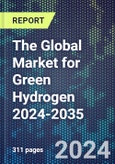Green hydrogen refers to hydrogen produced through renewable energy powered electrolysis of water, rather than carbon-intensive methods like steam methane reforming. It has no associated carbon emissions. Electrolyzer technologies are crucial for scaling up production of green hydrogen. Electrolyzers use electricity to split water into hydrogen and oxygen gas streams. These electrochemical systems along with renewable energy sources like solar, wind or hydro power enable renewable hydrogen production.
Cost declines through technology innovations, manufacturing scale-up and more renewable electricity integration are vital to displace existing fossil-based hydrogen supplying refining, fertilizer and chemical industries today. As green hydrogen scales, it can provide a sustainable energy storage vector and decarbonize sectors like steel, ammonia and transportation (through synthetic fuels) that lack easy electrification routes, playing a major role in achieving global net zero targets.
The Global Market for Green Hydrogen 2024-2035 provides a comprehensive overview of the emerging hydrogen economy and the pivotal role of green hydrogen production in enabling wider adoption across industrial applications. Spanning over 300 pages, the report analyzes global energy demand scenarios and the potential for hydrogen to deliver deep decarbonization across sectors from transportation to steel manufacturing.
Detailed technology analysis focuses on next generation electrolysis techniques for scalable green hydrogen generation from water and renewable electricity. Comparative assessment of alkaline, polymer electrolyte membrane, anion exchange membrane and solid oxide electrolysis systems explores component materials, system configurations, costs, manufacturing challenges and key innovative companies developing these technologies.
Additional sections profile developments around hydrogen storage and distribution infrastructure including pipelines, compression and liquefaction. The utilization segment covers fuel cell electric vehicles, synthetic fuel production, ammonia synthesis and other hydrogen end-uses across aviation, shipping and heat/power sectors.
The report covers >120 company profiles of major corporations, innovative start-ups and disruptive new entrants commercializing breakthroughs across the hydrogen value chain. Competencies span from advanced electrolyzer stacks to full solutions for onsite hydrogen generation, transportation fleets, renewable energy integration and industrial decarbonization projects.
Report contents include:
- Overview of the hydrogen economy and production landscape
- Analysis of global energy demand scenarios and hydrogen's decarbonization potential
- Breakdown of the hydrogen value chain - production, storage/transport, utilization
- Details on green hydrogen production methods, projects, and role in energy transition
- In-depth technology analysis of next-gen electrolyzers:
- Alkaline (AWE)
- Polymer Electrolyte Membrane (PEMEL)
- Anion Exchange Membrane (AEMEL)
- Solid Oxide (SOEC)
- Review of hydrogen storage and transportation infrastructure
- Coverage of utilization applications:
- Fuel cell electric vehicles
- Synthetic e-fuel production
- Green ammonia production
- Renewable power and heat generation
- Profiles of ~130 key companies across the hydrogen value chain:
- Industrial gas suppliers
- Emerging electrolyzer manufacturers
- Energy majors
- Chemical/ammonia companies
- Innovative start-ups
- Hydrogen production analysis for global regions
- Assessment of market challenges and growth drivers
Table of Contents
1 RESEARCH METHODOLOGY
Companies Mentioned (Partial List)
A selection of companies mentioned in this report includes, but is not limited to:
- Advanced Ionics
- Aemetis, Inc.
- Air Products
- Aker Horizons ASA
- Alchemr, Inc.
- Arcadia eFuels
- AquaHydrex
- AREVA H2Gen
- Asahi Kasei
- Atmonia
- Avantium
- BASF
- Battolyser Systems
- Blastr Green Steel
- Bloom Energy
- Boson Energy Ltd.
- BP
- Carbon Sink LLC
- Ceres Power Holdings plc
- Chevron Corporation
- Chiyoda Corporation
- Cockerill Jingli Hydrogen
- Convion Ltd.
- Cummins, Inc.
- C-Zero
- Dimensional Energy
- Domsjö Fabriker AB
- Dynelectro ApS
- ENEOS Corporation
- Elcogen AS
- Electric Hydrogen
- Elogen H2
- Enapter
- Equatic
- Ergosup
- Everfuel A/S
- EvolOH, Inc.
- Flexens Oy AB
- FuelCell Energy
- FuelPositive Corp.
- Fusion Fuel
- Genvia
- Graforce
- GeoPura
- Greenlyte Carbon Technologies
- Green Fuel
- Green Hydrogen Systems
- Heliogen
- Hitachi Zosen
- Hoeller Electrolyzer
- Honda
- H2B2 Electrolysis Technologies Inc
- H2Electro
- H2Greem
- H2 Green Steel
- H2Pro, Ltd.
- H2U Technologies
- H2Vector Energy Technologies, S.L.
- Hycamite TCD Technologies Oy
- HydrogenPro
- Hygenco
- HydGene Renewables
- HydrogenPro AS
- Hydrogenera
- Hydrogenics (part of Cummins)
- Hysata
- Hystar AS
- IdunnH2
- Infinium Electrofuels
- Ionomr Innovations
- ITM Power
- Kobelco
- Kyros Hydrogen Solutions GmbH
- Lhyfe S.A.
- LONGi Hydrogen
- McPhy Energy SAS
- Matteco
- NEL Hydrogen
- Newtrace
- Next Hydrogen Solutions
- Norsk e-Fuel AS
- OCOchem
- Ohmium International
- 1s1 Energy
- Ossus Biorenewables
- OXCCU Tech Ltd.
- OxEon Energy
- Parallel Carbon
- Peregrine Hydrogen
- Beijing PERIC Hydrogen Technologies Co.
- Perpetual Next Technologies
- Pherousa Green Shipping
- Plagazi AB
- Plenesys
- Plug Power, Inc.
- P2X Solutions Oy
- QD-SOL Ltd.
- Quantron AG
- Qairos Energies
- Resilient Energi
- Ryze Hydrogen
- SeeO2 Energy
- Shell plc
- Siemens Energy AG
- SoHHytec SA
- Sparc Hydrogen
- Stargate Hydrogen
- Storegga Geotechnologies Limited
- SungreenH2
- SunHydrogen
- Syzygy Plasmonics
- Thiozen
- Thyssenkrupp Nucera
- TFP Hydrogen Products
- Tokuyama
- Total Energies
- Tractebel Engie
- Travertine Technologies, Inc.
- Tree Energy Solutions (TES-H2)
- Twelve Corporation
- Verdagy
- Zhero
Methodology

LOADING...








